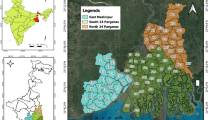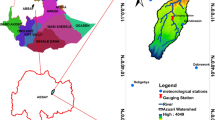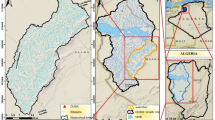Abstract
While historically significant for ancient civilizations, the Indus basin is also known for its floods and complex anthropogenic management history. Resulting from years of modifications by the pre-British era Mughal rulers followed by the post-partition division of river waters among the two neighbors, India and Pakistan, Pakistan faces severe management and financial challenges of water management. This study investigates the intricacies arising from this complicated management doctrine for the lower Indus basin. A detailed remote sensing-based analysis of the significant floods to hit the lower Indus basin since 2000 has been provided. Flood years were identified, and Moderate Resolution Imaging Spectroradiometer (MODIS) data for the years 2003, 2005, 2006, 2010, 2011, 2012, 2015, and 2016 were used to map their spatiotemporal extents. Almost all the flood water accumulated in the north is released in one river channel of the lower Indus basin. Further, the challenges were exacerbated due to the excessive rainfall in 2011 and 2012 in southeastern Sindh. A trend analysis of rainfall data shows an increase in the southern basin in the last 21 years, particularly toward the central plains and Sindh Province. The floodwater accumulated in the lower basin for as many as ~ 425 days on average, stretching to ~ 800 days of stagnancy in some places. The water stagnation period has been the highest in the river floodplain, highly populated and cultivated. The analyses of the current study suggest that the riverine channel has been better managed after the 2010 floods; however, the monsoon’s shift in 2011 and 2012 led to widespread disaster in low-lying regions of Sindh Province.











Similar content being viewed by others
Data availability
Data is available with the corresponding author and can be made available upon reasonable request.
Code availability
Snippets used to produce maps and graphs can be shared on request.
References
Adnan S, Ullah K (2020) Development of drought hazard index for vulnerability assessment in Pakistan. Nat Hazards 103(3):2989–3010
Ahamed A, Bolten JD (2017) A MODIS-Based Automated Flood Monitoring System for Southeast Asia. J Int J Appl Earth Observ Geoinf 61:104–117
Ahmad K (2003) Floods in Pakistan leave many dead or homeless J. The Lancet 362:542
Akhtar S (2011) The south Asiatic monsoon and flood hazards in the Indus river basin. Pakistan J Basic Appl Sci. https://doi.org/10.6000/1927-5129.2011.07.02.05
Alam S, Ansari R (2000) Agricultural Land Scenario of Sindh Province Nuclear Institute of Agriculture Tando Jam, Pakistan
Ali A (2013) Indus basin floods: mechanisms, impacts, and management. Asian Development Bank. Available online https://think-asia.org/handle/11540/810. Accessed 12 Jan 2021
Ali J, Syed KH, Gabriel HF, Saeed F, Ahmad B, Bukhari SAA (2018) Centennial heat wave projections over Pakistan using ensemble NEX GDDP data set. J Earth Syst Environ. https://doi.org/10.1007/s41748-018-0064-8
Ali SM, Khalid B, Akhter A, Islam A, Adnan S (2020) Analyzing the occurrence of floods and droughts in connection with climate change in Punjab province. Pak Nat Hazards 103:2533–2559
Arai T (2012) Rebuilding Pakistan in the Aftermath of the Floods: Disaster Relief as Conflict Prevention. J Peacebuilding Develop 7:51–65
Archer DR, Fowler HJ (2004) Spatial and temporal variations in precipitation in the upper indus basin, global teleconnections and hydrological implications. Hydrol Earth Syst Sci 8:47–61
Aslam K, Rashid S, Saleem R, Aslam RMS (2015) Use of geospatial technology for assessment of waterlogging and salinity conditions in the Nara Canal Command area in Sindh. Pak J Geograph Inf Syst 7:438
Atif S (2012) The lower indus basin: an anthropogenically modified basin under the influence of extreme events. Denis Diderot University, Paris VII, France
Basharat M, Riaz MT, Jan MQ, Xu C, Riaz S (2021) A review of landslides related to the 2005 Kashmir Earthquake: implication and future challenges Natural Hazards:1–30. https://doi.org/10.1007/s11069-021-04688-8
Berz G (2000) Flood disasters: lessons from the past—worries for the future. In: Proceedings of the institution of civil engineers-water and maritime engineering, vol 142 (1). pp 3–8. https://doi.org/10.1680/wame.2000.142.1.3
Brakenridge GR (2018) Flood risk mapping from orbital remote sensing. IN: Schumann GJ-P, Bates PD, Apel H, Aronica GT (eds) Global flood hazard: Applications in modeling, mapping, forecasting, vol 33, First Edition, pp 43–54. https://doi.org/10.1002/9781119217886.ch3
Dao PD, Liou Y-A (2015) Object-based flood mapping and affected rice field estimation with Landsat 8 OLI and MODIS data. J Remote Sensing 7:5077–5097
De Groeve T, Brakenridge G, Paris S (2015) Global flood detection system data product specifications. Joint research centre: brussels, Belgium. https://www.gdacs.org/flooddetection/Download/Technical_Note_GFDS_Data_Products_v1.pdf. Accessed 02 Jan 2021
Fayne JV (2015) A comparison of reclassification methods to improve an NDVI based flood map. Masters of science dissertation. George Mason University. http://ebot.gmu.edu/bitstream/handle/1920/9713/Fayne_thesis_2015.pdf. Accessed 06 Feb 2021
Fayne JV, Bolten JD, Doyle CS, Fuhrmann S, Rice MT, Houser PR, Lakshmi V (2017) Flood mapping in the lower Mekong River Basin using daily MODIS observations J. Int J Remote Sens 38:1737–1757
Fick SE, Hijmans RJ (2017) WorldClim 2: new 1-km spatial resolution climate surfaces for global land areas. Int J Climatol 37:4302–4315
Gumma MK et al (2011) Changes in agricultural cropland areas between a water-surplus year and a water-deficit year impacting food security, determined using MODIS 250 m time-series data and spectral matching techniques, in the Krishna River basin (India). J Int J Remote Sens 32:3495–3520
Hanif M, Khan AH, Adnan S (2013) Latitudinal precipitation characteristics and trends in Pakistan. J Hydrol 492:266–272
Haq M, Akhtar M, Muhammad S, Paras S, Rahmatullah J (2012) Techniques of Remote Sensing and GIS for flood monitoring and damage assessment: a case study of Sindh province. Pak J Egyptian J Remote Sens Space Sci 15:135–141
Hartmann H, Andresky L (2013) Flooding in the Indus River basin—a spatiotemporal analysis of precipitation records. Global Planet Change 107:25–35
Hewitt K (2011) Glacier change, concentration, and elevation effects in the Karakoram Himalaya. Upper Indus Basin J Mountain Res Develop 31:188–200
Holmes DA (1968) The recent history of the Indus. Geogr J 134:367–382. https://doi.org/10.2307/1792965
Hossain MS, Bujang JS, Zakaria MH, Hashim M (2015) Assessment of the impact of landsat 7 scan line corrector data gaps on Sungai Pulai Estuary seagrass mapping. J Appl Geomat 7:189–202
Hudson PF, Middelkoop H, Stouthamer E (2008) Flood management along the Lower Mississippi and Rhine Rivers (The Netherlands) and the continuum of geomorphic adjustment. Geomorphology. https://doi.org/10.1016/j.geomorph.2008.07.001
Immerzeel W, Wanders N, Lutz A, Shea J, Bierkens M (2015) Reconciling high-altitude precipitation in the upper indus basin with glacier mass balances and runoff. J Hydrol Earth Syst Sci 19:4673–4687
Jorgensen DW, Harvey MD, Schumm SA, Flam L (1993) Morphology and dynamics of the Indus River: Implications for the Mohen Jo Daro site Himalaya to the sea: geology, geomorphology and the Quaternary. Doi: https://doi.org/10.4324/9780203414637_chapter_15
Kale VS (2003) Geomorphic Effects of Monsoon Floods on Indian Rivers. In: Mirza MMQ, Dixit A, Nishat A (eds) Flood Problem and Management in South Asia. Springer Netherlands, Dordrecht, pp 65–84. doi:https://doi.org/10.1007/978-94-017-0137-2_3
Kazi A (2014) A review of the assessment and mitigation of floods in Sindh. Pakistan J Natural Hazards 70:839–864
Kazmi AH, Jan MQ (1997) Geology and tectonics of Pakistan. Graphic Publishers, Karachi Pakistan. https://lgc2016.files.wordpress.com/2016/03/geology-tectonics-of-pakistan-by-kazmi-qasimjan.pdf
Khalid B, Cholaw B, Alvim DS, Javeed S, Khan JA, Javed MA (2010) Khan AH (2018) Riverine flood assessment in Jhang district in connection with ENSO and summer monsoon rainfall over Upper Indus Basin for. J Natural Hazards 92:971–993
Khan MZ et al (2014) Effect of right bank outfall drain (RBOD) on biodiversity of the wetlands of Haleji wetland complex. Sindh J Canadian J Pure Appl Sci 8:2871–2900
Khandelwal A, Karpatne A, Marlier ME, Kim J, Lettenmaier DP, Kumar V (2017) An approach for global monitoring of surface water extent variations in reservoirs using MODIS data J Remote sensing of. Environment 202:113–128
Klein I, Gessner U, Dietz AJ, Kuenzer C (2017) Global WaterPack–A 250 m resolution dataset revealing the daily dynamics of global inland water bodies. J Remote Sens Environ 198:345–362
Konishi T (2018) Project information document-integrated safeguards data sheet-sindh barrages improvement project AF-P162117. The World Bank. http://documents1.worldbank.org/curated/en/849641523529033367/pdf/Project-Information-Document-Integrated-Safeguards-Data-Sheet-Sindh-Barrages-Improvement-Project-AF-P162117.pdf. Accessed 17 Dec 2020
Kwak E (2013) Automatic 3D building model generation by integrating LiDAR and aerial images using a hybrid approach. Doctoral dissertation, University of Calgary. https://doi.org/10.11575/PRISM/25078
LAADS W (2008) Level 1 and atmosphere archive and distribution system. J National Aeronautics Space Administration. https://ladsweb.nascom.nasa.gov/data/search.html. Accessed on 15 nov 2020
Laghari J (2013) Climate change: melting glaciers bring energy uncertainty. J Nature News 502:617
Lashari BK, Khero ZI (2010) Disastrous effects of rain 2011 in Sindh, Pakistan. In: Proceedings of Symposium on “Emerging Phenomenon of Untimely Rains / Floods – 2011 in Pakistan”. Karahi Pakistan. https://pecongress.org.pk/images/upload/books/95-104-301%20DISASTROUS%20EFFECTS%20OF%20rain%202011%20in%20Sindh%20New%20mail%201.11.2012.pdf
Looney R (2012) Economic impacts of the floods in Pakistan. J Contemp South Asia 20:225–241
Lutz AF, Immerzeel WW, Kraaijenbrink PD, Shrestha AB, Bierkens MF (2016) Climate change impacts on the upper indus hydrology: Sources, shifts and extremes. J PloS one 11:e0165630. https://doi.org/10.1371/journal.pone.0165630
Ma B, Wu L, Zhang X, Li X, Liu Y, Wang S (2014) Locally adaptive unmixing method for lake-water area extraction based on MODIS 250 m bands. J Int J Appl Earth Observ Geoinf 33:109–118
Mahessar AA, Qureshi AL, Siming IA, Kori SM, Dars GH, Channa M, Laghari AN (2019) Flash flood climatology in the lower region of Southern Sindh. J Eng Technol Appl Sci Res 9:4474–4479
Mahmood S, Hamayon K (2021) Geo-spatial assessment of community vulnerability to flood along the Ravi River, Ravi Town, Lahore, Pakistan. Nat Hazards 106(1):2825–2844. https://doi.org/10.1007/s11069-021-04568-1
Mahmood S, Rahman A-u, Sajjad A (2019) Assessment of 2010 flood disaster causes and damages in district Muzaffargarh, Central Indus Basin. Pakistan J Environ Earth Sci 78:63
Mahmood S, Sajjad A & Rahman A-u (2021) Cause and damage analysis of 2010 flood disaster in district Muzaffar Garh, Pakistan. Nat Hazards 107:1681–1692. https://doi.org/10.1007/s11069-021-04652-6
Martinis S, Twele A, Strobl C, Kersten J, Stein E (2013) A multi-scale flood monitoring system based on fully automatic MODIS and TerraSAR-X processing chains. J Remote Sens 5:5598–5619
Molnia BF (2008) Glaciers of North America -- Glaciers of Alaska. In: Williams RS, Ferrigno JG (eds) Satellite image atlas of glaciers of the world: U.S. Geological Survey Professional Paper 1386-K. https://pubs.usgs.gov/pp/p1386k/. Accessed 22 Jan 2021
Mukhopadhyay B, Khan A (2015) A reevaluation of the snowmelt and glacial melt in river flows within Upper Indus Basin and its significance in a changing climate J. J Hydrol 527:119–132
Munawar HS, Hammad A, Ullah F, Ali TH (2019) After the flood: A novel application of image processing and machine learning for post-flood disaster management. In: Proceedings of the 2nd international conference on sustainable development in civil engineering (ICSDC 2019), Jamshoro Pakistan, pp 52–61. https://www.researchgate.net/profile/Fahim-Ullah/publication/337773028_After_the_Flood_A_Novel_Application_of_Image_Processing_and_Machine_Learning_for_Post-Flood_Disaster_Management/links/5de98833a6fdcc28370938f4/After-the-Flood-A-Novel-Application-of-Image-Processing-and-Machine-Learning-for-Post-Flood-Disaster-Management.pdf
Munawar HS, Qayyum S, Ullah F, Sepasgozar S (2020) Big data and its applications in smart real estate and the disaster management life cycle: a systematic analysis big data and cognitive computing. 4:4. https://doi.org/10.3390/bdcc4020004
Mustafa D, Wrathall D (2011) Indus basin floods of 2010: Souring of a faustian bargain? J Water Altern 4(1):72–85
Nazeer M, Bork H-R (2021) A local scale flood vulnerability assessment in the flood-prone area of Khyber Pakhtunkhwa. Pakistan Natural Hazards 105:755–781
Nigro J, Slayback D, Policelli F, Brakenridge GR (2014) NASA/DFO MODIS near real-time (NRT) global flood mapping product evaluation of flood and permanent water detection J Evaluation, Greenbelt, MD 27. Nasa Report. https://floodmap.modaps.eosdis.nasa.gov//documents/NASAGlobalNRTEvaluationSummary_v4.pdf
Palmer MA, Reidy Liermann CA, Nilsson C, Flörke M, Alcamo J, Lake PS, Bond N (2008) Climate change and the world’s river basins: anticipating management options J. Front Ecol Environ 6(2):81–89
Partal T, Kahya E (2006) Trend analysis in Turkish precipitation data J Hydrological Processes: An. Int J 20:2011–2026
Paterson DL, Wright H, Harris PN (2018) Health risks of flood disasters. Clin Infect Dis 67:1450–1454
Pervez MS, Budde M, Rowland J (2014) Mapping irrigated areas in Afghanistan over the past decade using MODIS NDVI J. Remote Sens Environ 149:155–165
Policelli F, Slayback D, Brakenridge B, Nigro J, Hubbard A, Zaitchik B, Carroll M, Jung H (2017) The NASA global flood mapping system. In: Remote sensing of hydrological extremes. Springer, Cham, pp 47–63. https://doi.org/10.1007/978-3-319-43744-6_3
Qureshi AS (2011) Water management in the Indus Basin in Pakistan: challenges and opportunities j. Mountain Res Develop 31:252–260
Qureshi AL, Mahessar AA, Leghari ME-U-H, Lashari BK, Mari FM (2015) Impact of releasing wastewater of sugar industries into drainage system of LBOD Sindh, Pakistan. J Int J Environ Sci Develop 6:381
Razavi S, Vogel R (2018) Prewhitening of hydroclimatic time series? implications for inferred change and variability across time scales j. J Hydrol 557:109–115
Sarwar S (2013) Reservoir life expectancy in relation to climate and land-use changes: case study of the mangla reservoir in Pakistan. University of Waikato, Doctoral
Schilling J, Vivekananda J, Khan MA, Pandey N (2013) Vulnerability to environmental risks and effects on community resilience in mid-west Nepal and south-east Pakistan J Environment. Nat Resour Res 3:27
Schütte S, Kreutzmann H (2012) Social Vulnerability in Sindh recent floods as amplifiers of social crisis in pakistan. J Internationales Asienforum 43:199–221
Sharma SK, Misra SK, Singh JB (2020) The role of GIS-enabled mobile applications in disaster management: A case analysis of cyclone Gaja in India. Int J Inf Manag 51:102030
Shroder Jr JF (2002) Himalaya to the sea: geomorphology and the Quaternary of Pakistan in the regional context. In: Himalaya to the Sea. Routledge, pp 21–47. https://www.taylorfrancis.com/chapters/edit/10.4324/9780203414637-12/himalaya-sea-geomorphology-quaternary-pakistan-regional-context-john-shroder-jr
Sudaryo MK, Besral MF, Umniyati H, Guha-Sapir D (2020) Acute Infection Following Flood Disaster: an Example from Bojonegoro District East Java, Indonesia Indian. J Public Health Res Develop 11:2442–2448
Syvitski JP, Brakenridge GR (2013) Causation and avoidance of catastrophic flooding along the Indus River. Pakistan J GSA Today 23:4–10
Tabari H, Taye MT, Willems P (2015) statistical assessment of precipitation trends in the upper blue Nile river basin. J Stochastic Environ Res Risk Assess 29:1751–1761
Uddin K, Gurung DR, Giriraj A, Shrestha B (2013) Application of remote sensing and GIS for flood hazard management: a case study from Sindh Province. Pakistan J Am J Geograph Inf Syst 2:1–5
Vermote E, Kotchenova S (2008) MOD09 (Surface Reflectance) User's Guide, Version 1.1, March, 2008 J Greenbelt, MD. http://modis-sr.ltdri.org/MAIN_SURFACE_PRODUCTAND%20USER%20GUIDE/MOD09_UserGuide.pdf. Accessed 02 Dec 2020
Water and Power Development Authority (2016) Tarbela 5th extension hydropower project: Environmental and social assessment – executive summary. Government of Pakistan Web R Pakistan floods: Situation Report No. 5 - Pakistan. http://documents1.worldbank.org/curated/en/787431468290411161/pdf/SFG1900-V2-EA-P157372-Box394869B-PUBLIC-Disclosed-3-3-2016.pdf. Accessed 07 Jan 2021
Webster P, Toma VE, Kim HM (2011) Were the 2010 Pakistan floods predictable? J Geophys Res Lett 38(4):1–5. https://doi.org/10.1029/2010GL046346
Westra S, Alexander LV, Zwiers FW (2013) Global increasing trends in annual maximum daily precipitation J. J Clim 26:3904–3918
Yao T et al (2012) Different glacier status with atmospheric circulations in Tibetan plateau and surroundings. J Nature Clim Change 2:663–667
Yin L (2017) Street level urban design qualities for walkability: Combining 2D and 3D GIS measures Computers. Environ Urban Syst 64:288–296
Yu L, Shi Y, Gong P (2015) Land cover mapping and data availability in critical terrestrial ecoregions: a global perspective with Landsat thematic mapper and enhanced thematic mapper plus data J. Biol Cons 190:34–42
Yue S, Pilon P, Phinney B, Cavadias G (2002) The influence of autocorrelation on the ability to detect trend in hydrological series J. Hydrol Process 16:1807–1829
Funding
The article received no funding from any private, government, or not-for-profit organization.
Author information
Authors and Affiliations
Corresponding author
Ethics declarations
Conflict of interest
The authors declare that there is no conflict of interest.
Additional information
Publisher's Note
Springer Nature remains neutral with regard to jurisdictional claims in published maps and institutional affiliations.
Rights and permissions
About this article
Cite this article
Atif, S., Umar, M. & Ullah, F. Investigating the flood damages in Lower Indus Basin since 2000: Spatiotemporal analyses of the major flood events. Nat Hazards 108, 2357–2383 (2021). https://doi.org/10.1007/s11069-021-04783-w
Received:
Accepted:
Published:
Issue Date:
DOI: https://doi.org/10.1007/s11069-021-04783-w




